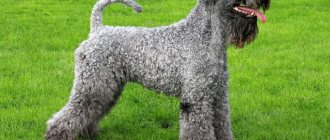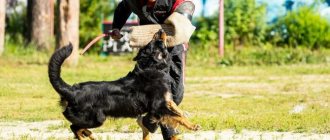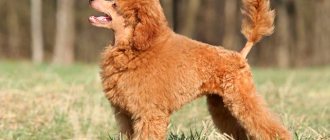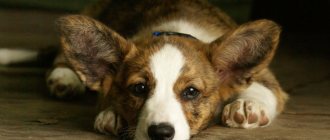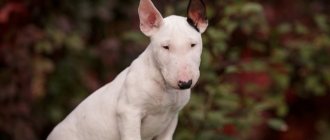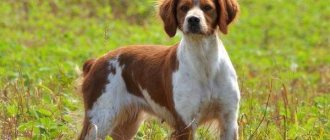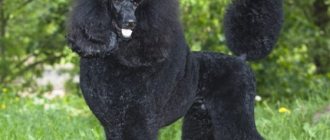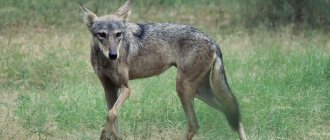The German Shepherd is one of the most widely known dogs in the world. Due to the breed's rich history and great cultural influence in various world societies, they are one of the most respected dog breeds. This is due in part to their intelligence, compatibility with people, and usefulness as a working dog.
A detailed full description of this wonderful breed can be read here.
There are only two officially recognized breeds of German Shepherd, but there are many other ways to differentiate this breed. Here we will look at the different types, classifications and names with photos to understand what types of German Shepherds there are.
History of the origin of the breed
Large and strong dogs with light colors, reminiscent of modern shepherd dogs, appeared long before our era, as evidenced by ancient chronicles. Engravings from the 15th–16th centuries depicting the ancestors of animals with dark long hair can be seen in German museums. Since the 19th century, German farms have bred shepherd dogs with massive bodies as watchmen and shepherds. In the southern part of the country, a type of calmer animal was used, but not inferior in quality to squat dogs. When these varieties were crossed, the short-haired shepherd appeared.
The father thought that Max Emil would become an officer, but his son, obsessed with the desire to create a universal breed of dogs, left military service to study at veterinary college. While visiting the exhibition, von Stefanitz liked the dog, and the biologist begged the owner to sell him the animal to create a breed standard. A breeder noticed that sometimes a pair of short-haired shepherd dogs give birth to shaggy puppies. Von Stefanitz mistakenly believed that long hair, when wet in water, takes a long time to dry, the skin becomes heavy and prevents dogs from running and jumping.
Fluffy puppies were not allowed to show, considering them a defect in the breed. The long-haired German Shepherd was not used for breeding. Over time, breeders began to note that the shaggy pups born in the litter of dogs with short hair are strong and healthy; their long hair protects them from the cold in harsh climates and prevents them from overheating in the heat.
Puppies stopped being culled only in 2011, when, at the request of the German Federation of Cynologists, shepherd dogs with long hair were classified as an independent type of breed, which has many advantages compared to dogs with short hair.
Breeders decided that the reason for the appearance of unusual puppies was inheritance from distant ancestors of a recessive gene.
Photo and video review
To finally make sure that the long-haired shepherd is worth paying attention to, it is suggested that you look at photos and short videos about these dogs.
Long-haired German Shepherds are rightfully considered a unique breed. If you choose her, you can be sure that in the end she will grow up to be an intelligent, fearless and loyal animal.
Size and weight
The height of the male reaches 60 cm, in some specimens - 65, the female is 5 centimeters lower than the male. The body weight of a furry pet does not exceed 40 kilograms, girls weigh from 22 to 30. The purity of the breed is determined by standard characteristics:
| Body parts | Description |
| Head | folded proportionally, widens in the skull area, narrows towards the nose |
| Ears (erect) | have a triangle shape, set high |
| Eyes | colored brown or black, almond-shaped |
| Neck | powerful and muscular |
| Paws | straight with developed joints, the front ones are parallel to each other, the rear ones are slightly apart |
| Back | elongated, strong |
| Stomach | fit |
The chest of a fluffy shepherd with pronounced withers is deep and oval in shape. The animal's saber-shaped tail is covered with dense fluffy vegetation.
The purity of the breed is indicated by the black color of the wet lobe, the presence of a correct bite, and the presence of a formula consisting of 42 teeth.
Standard, description of appearance and color
According to the FCI (Fédération Cynologique Internationale), the breed standard for the long-haired Alsatian Shepherd is no different from the description of a regular short-haired animal. Only the types of wool differ.
Apart from the length of the coat, long-haired BUTs are no different from short-haired ones.
Head
Dry and large with a convex forehead and a noticeable transition to the muzzle. The eyes are dark brown, the nose is large and black. The jaws are powerful and have a scissor bite.
Torso
The description of the breed provides for a powerful neck without dewlap. The withers are pronounced. The back is long and strong. The croup is sloping and goes into the base of the tail. The chest is powerful and round. The stomach is taut.
Front limbs
Straight, parallel to each other, well developed. The feet are round, with hard pads and dark nails.
Hind limbs
Powerful thighs approximately the same length as the lower legs. Paws are collected, rounded. Hard pads, dark claws.
Color
Acceptable are black and red, saddleback and black representatives of the breed. Black Alsatian dogs can be tinged with red or deep brown.
A black mask on the face is acceptable. The brighter it is, the higher the dog is valued.
Long-haired German Shepherd with a black mask on his face
Wool
Thick and long with dense undercoat.
Size and weight
The minimum height of a male dog is 60 centimeters. Weight - 35-45 kilograms. The minimum height of a female is 55 centimeters. Weight 32-42 kilograms.
Long-haired DO needs to be combed 3-4 times a week
Color and coat type
The fluffy shepherd is almost no different in temperament, behavior, and character from its German counterparts, but its entire body is covered with shiny, elongated hair. The densest fringes are observed:
- behind the ears,
- on the inside of the paws,
- in the chest area.
On the back of the shepherd, the black hair is separated by an even, neat parting. There are representatives of the breed with saddle-colored wool or a combination of red, gray, yellow, whose elongated hair lies in thick waves and is slightly curly.
Reference! A serious deviation from the shepherd standard is the presence of light and white shades on the coat.
Sometimes you see dogs with a pointed muzzle, with a narrow rather than oval chest, but the ears of the German Shepherd are proportionally positioned.
Diseases and life expectancy
Despite the good health of German Shepherds, long-haired dogs often have:
- joint dysplasia;
- vision problems;
- dermatitis;
- ear infections;
- pancreatic diseases;
- paralysis of the hind limbs (usually adult males are affected).
There is an opinion that representatives of black color are more often infected with distemper.
There is an opinion that representatives of black color are more often infected with distemper.
- diseases of the spine;
- diabetes;
- lack of growth hormone;
- problems with the cardiovascular system;
- epilepsy;
- oncology.
The average life expectancy of a long-haired representative of the breed is 11 years, but with good maintenance it can reach 15.
Health and Diseases of the Longhaired German Shepherd
Although the shaggy dog has a strong immune system, pets are exposed to viruses, more often than other breeds they have problems with the spine, suffer from epilepsy, and diabetes. In shepherd dogs with a long coat consisting of hard or soft hair, the following is detected:
- skin dermatitis;
- pathology of the pancreas;
- joint dysplasia;
- malignant tumors.
Sometimes pets' vision deteriorates and their ears are affected by a bacterial infection. Longhaired German Shepherd puppies are often found to be deficient in growth hormones. The pet's behavior and hair condition indicate the presence of health problems. If there is a lack of calcium in the body, the dog licks chalk, if there is a lack of nicotinic acid, it chews cigarette butts, and if there is a deficiency of cobalamin, it eats excrement.
Males suffer from paralysis of their hind legs. The animal has difficulty getting up and cannot overcome the obstacle. As the disease progresses, urinary incontinence increases and the dog dies or is euthanized.
Diseases and health
Long-haired German, owner of good immunity and fairly stable health. There are certain predispositions that are transmitted at the genetic level:
- Dyplasia of large joints;
- Allergic reactions to medications, food allergens;
- Problems with the musculoskeletal system in general;
- Weak stomach;
- Otitis;
- Age-related diseases of the organ of vision.
Life expectancy with decent care and good nutrition: 12 -15 years. It is especially important to ensure sufficient physical activity and active pastime. And also attention and care.
Character
Representatives of the breed delight owners with their poise and devotion. The Black German Shepherd does not leave its owner in trouble, rarely shows jealousy, is friendly towards the owner’s environment, and in a dangerous moment is able to protect him at the cost of his life. Dogs with long hair inherited from their ancestors:
- hunting skills;
- courage and patience;
- activity and need for movement.
It is recommended to regularly take both puppies and adult pets kept at home for long walks. The long-haired dog does not pick up foreign objects on the street, does not damage furniture, and understands without a command how to act if it is necessary to protect property.
After appearing in the house, the shaggy man independently chooses an owner with a strong character, whom he will obey unquestioningly.
Character, training and education
In the process of establishing the breed, the breeders did their best and turned the shepherd into a truly universal breed. She has protective and guard qualities, she is well oriented towards people, learns quickly, and understands her owner perfectly. Such a dog is a real find even for a novice owner, as she has an easy-going character.
Puppy BUT requires daily attention
When properly trained, long-haired shepherd dogs grow up to be kind and playful dogs. They love active games with their owner, but they can also adapt to short-term solitude. If you establish contact with the puppy, in the future he will be easily trained and will learn to understand the intonations of the owner. To do this, you need to spend a lot of time with the dog, both on walks and at home. You should not leave your puppy to his own devices or always let him play with other dogs on the street. Contact with the owner is the key to understanding.
Note! You can train a shepherd dog from the age of two to three months. Such basic commands as “sit”, “lie down”, “come to me”, “take your place”, “ugh!” must be mastered without fail. You can reward your puppy with a toy, a treat, and lots of praise. It is better to ignore unwanted behavior rather than punish it.
Intelligence and training
The Germans are capable of performing complex tasks. Fluffy pets accompany the blind, participate in rescue operations, and guard important objects.
By the way! Shepherd dogs with beautiful long hair are not inferior in intelligence to either the poodle or the collie, which are considered the smartest dogs.
You need to educate an animal from an early age, and this can be done by the owner, whom the dog will mistake for the leader. You cannot allow a puppy to ignore prohibitions or turn a blind eye to disobedience; you must prohibit the dog from:
- lying on the sofa;
- ask for food from the table;
- climb into a chair.
From a month on, you should train your pet to respond to a nickname, from two months - not to bark at others for no reason, from four months - to the commands “Near”, “Lie down”, encouraging with treats and games. If the dog is planned to be used to perform search functions, the training should be entrusted to a dog handler. Training should be carried out regularly, otherwise the puppy will forget the commands, and it is very difficult to retrain it, but dog breeders do not recommend overloading the pet with physical exercises for up to a year, since the animal’s muscles have not yet had time to get stronger.
Is it suitable for keeping outdoors and in an apartment?
The German Shepherd feels best in a private home. Their long fur allows them to stay warm even in cold weather. But it is important to remember that in winter the shepherd will need an insulated booth.
A long-haired shepherd dog can live in an apartment if you take it for a walk at least twice a day. Walks should be quite long and active. However, you need to remember that German Shepherds kept in an apartment shed heavily.
In addition, these dogs react very sensitively to the slightest noise and can bark in the absence of their owners.
Pros and cons of the breed
A shepherd with long hair trains well, but is still a little worse than a short-haired breed, requiring long walks and regular exercise. The advantages of the shaggy “German” are considered to be:
- courage;
- endurance;
- devotion.
Reference! The pet does not show aggression without reason, has high security qualities, and can be used by the police and rescue services.
Many representatives of the long-haired breed do not have a balanced psyche. Dogs with a frantic temperament get excited quickly and cannot cope with the unbridled energy on their own. With such a shepherd you need to work long and hard, constantly take him for long walks, otherwise the pet in the house will turn everything upside down. Depending on the character, both the rules of care and training are subject to adjustment. Among the representatives of the long-haired breed there are also dogs with a retarded psyche that need different training.
Distinctive features and character
The long-haired shepherd entered the breed standard eight years ago. Before this, it was considered a tribal marriage. Puppies were sold without a pedigree.
In March 2010, Germany decided to include long-haired Alsatian dogs in the standard. This is due to their frequent birth rate and the demand for such puppies, even though they could not be bred and exhibited.
Most fluffy German Shepherds have a rather unbalanced psyche. This manifests itself both in the direction of a crazy temperament and inhibition. The first dogs are typical cholerics. They undergo excitation processes very quickly, but there is trouble with inhibition. For the second, the opposite is true.
If such a choleric person appears at home, then you will have to deal with him especially long and carefully. Representatives of the breed are not always obedient; their energy is in full swing. You need to be given the opportunity to throw it away. Long walks with physical activity will help with this. These dogs need to be exhausted with training and walks, otherwise the owner’s apartment will suffer.
The shepherd's energy must be channeled into a peaceful channel, otherwise the owner's property will suffer.
At home, “long dogs” are sociable and sweet dogs. Family members are loved, or create the appearance of love. If a dog is phlegmatic, it is indifferent to the caresses of its owner. Choleric in mood: either he comes to caress, or he can growl.
It is trainable, but not as easy as a standard German Shepherd. Long-haired dogs have a very difficult flaw to correct: if this dog is afraid of something once, then it is very difficult to wean it from being afraid of this irritant. As a child, a puppy was frightened by a bush that moved sharply in the wind. An adult dog, approaching the bushes, will try to growl at them.
Maintenance and care
An animal lover and even a child can take care of a shaggy German Shepherd. A brave dog feels comfortable in a spacious enclosure; owners of apartments in a high-rise building should breed dogs of this breed only if the owner has enough time for regular walks with the pet lasting at least 2 hours. It is recommended to focus the care and maintenance of a shepherd on developing skills and promoting activity.
The animal's fur can be easily combed with a medium-hard comb, and this should be done twice a week. When an animal sheds, the body expends a large amount of energy to grow new hairs. To prevent the pet from weakening or losing weight, they increase nutrition, include foods containing vitamins in the diet, and, on the recommendation of a doctor, give medications that strengthen the coat. To stimulate blood circulation, brush your shepherd every day.
Bathe your pet once every 3 months, during the procedure:
- The dog's coat is moistened with water.
- Apply a special shampoo, being careful not to get the product into the animal’s eyes.
- When foam appears, the composition is carefully washed off.
Attention! Every day you need to check the condition of the shepherd's eyes, remove discharge with a damp cloth, and clean the ears of dust and dirt with a cotton swab.
To avoid the appearance of cracks and rotting, it is advised to regularly examine the paws, mouth, nose and lips. Tartar and plaque on teeth must be removed using special toothpastes for dogs.
To prevent diseases, vaccinations for shepherd dogs should be done on a schedule, and not when there is free time. Treating wool with antiparasitic agents gets rid of fleas and other microscopic insects that live in the hair of animals.
It is recommended to include natural food containing a large amount of protein in the diet of a long-haired shepherd dog. The dog is fed beef, turkey, veal, lamb, dairy products, fish, and fresh fruit. You should not give your German pet:
- sweets and flour;
- potato and bean dishes;
- sparkling water;
- fried and smoked;
- any pickles.
Puppies can chew sugar bones, but tubular ones are strictly prohibited. German shepherds are not averse to eating strawberries, crackers, and chicken eggs. It is recommended to purchase premium ready-made dog food containing meat, grains and cereals, since representatives of the breed often suffer from allergies. Puppies up to 2 months are fed 6 times a day, up to 3 - five times, up to 6 - four times a day. Excessive consumption of foods negatively affects the development of bones and muscles.
Attention! Adult pets are fed morning and evening, six-month-old pets three times a day.
What to feed
There is an ongoing debate among breeders and dog handlers about what to give shepherd dogs - natural products or dry food.
Both options are allowed, but the main condition is a smooth change of diet. The transition from ready-made food to regular food should not take place “in one day”: new ingredients are mixed into the old food over the course of a week.
Let's move on to the menu.
Puppy
In the first month of life, the baby's diet consists exclusively of milk. The cow, goat or sheep product is heated to +27°...+30° and administered using a pipette, baby bottle or syringe without a needle.
Find out more about the selection criteria and features of caring for a German Shepherd puppy.
The daily norm for up to 14 days is 2/3 glasses, divided into 4-5 doses; from 15 days to a month it is gradually increased to two glasses (with 6 approaches).
From the month they switch to food more familiar to shepherds:
- lean beef;
- bird;
- boiled offal;
- boiled fish (strictly without bones);
- boiled eggs - once every 3-4 days;
- rice or buckwheat mixed with grated herbs or vegetables. Among them are carrots and pumpkin, beets and cabbage.
For a puppy, it is important to maintain a balance between cereals and animal products (ideally 70/30).
Important! When feeding a small shepherd, it is better to use a plate on a stand - this way the pet will not bend over too much (which is important for an animal with growing bones).
You can also take special dry food for young shepherds without skimping on super-premium mixtures.
When feeding, they try to maintain a daily routine, taking into account the age characteristics of the dogs. For example, from 1.5 to 3 months, feeding is reduced to 4 meals (3-3.5 glasses of food per day). From 3 to 6 they practice 3 meals a day.
From six months to a year, they focus on the pet’s health status. For slightly weakened dogs, a “triple” diet is maintained with an increase in the volume of food to a total of 1.5 liters per day. Healthy animals can be safely transferred to 2 feedings a day, which is considered standard for adults.
Let’s not forget about vitamins , or rather mineral complexes. They act as additives to the main food. For a growing body, the presence of glucosamine, calcium, phosphorus and chondroitin sulfate is extremely important.
When buying complementary foods, they give preference to formulations containing these elements. The dosage is indicated on the packaging.
Did you know? After the war, mention of these shepherd dogs disappeared in English and American stud books - until the mid-1970s, puppies were recorded as “Alsatian dogs.”
Adult dog
In terms of permitted foods, the diet of an adult dog is identical to the menu of a growing puppy. The whole difference is in proportions and quantity.
The standard scheme is:
- 1/3 comes from meat. It can be fresh or scalded chicken or boiled lean beef. All this is exchanged for fish once a week;
- another third is the sum of vegetables and dairy products. Be careful with whole milk: it can cause diarrhea;
- The share of cereals in the daily amount of food is approximately the same. Rice, buckwheat and millet are the best.
Shepherd dog owners often make the mistake of believing that the dog will willingly eat what lands on its plate from the kitchen table. This is not so - there is a very specific list of forbidden products, among which are :
- white bread and vermicelli;
- citrus fruits;
- grape;
- pearl barley porridge;
- lentils and beans;
- potato;
- peas;
- sorrel.
Did you know? Dogs identify the source of sound in 1/600 of a second!
As for fruits, they are used exclusively as a dessert additive - finely chopped apples or pears are given a maximum of three times a week.
How to choose a long-haired German Shepherd puppy
To avoid purchasing a mongrel instead of a purebred purebred dog, you do not need to buy a furry baby on the market, but rather visit a nursery after reading information and reviews about it first.
When choosing a furry puppy, it is advisable to look at what the parents look like and in what conditions adult dogs and babies are kept. It is recommended to abandon the offspring if the previous time its mother gave birth was less than a year ago.
Healthy German Shepherd puppies are active and have straight, strong legs. There is no secretion coming out of the babies' ears, their eyes are clear, their moist nose is shiny. A baby infected with helminthiasis has a distended abdomen.
A breeder who sells the offspring of a German Longhaired Shepherd is required to present all documents with marked vaccinations. The price of a puppy with a good pedigree in the nursery reaches 70 thousand rubles, the average cost is 20 thousand.
With proper upbringing and timely training, a German Shepherd with thick long hair pleases with loyalty, high intelligence and fearlessness. The pet will not allow strangers into the house and will protect the owner from evil people.
Choosing a puppy
The decision to purchase a dog requires a serious approach. A lot of attention, time and money are required, especially if the shepherd is large and shaggy.
The choice of a puppy must be made consciously, with an understanding of the purpose for which it is purchased.
The breed has show class representatives - attractive shaggy dogs of black and brown color, participating in show rings. And there are active working shepherd dogs with a pronounced guard character. They usually have a zonal color (gray, black, yellow).
The breed has show class representatives - attractive shaggy dogs of black and brown color, participating in show rings. And there are active working shepherd dogs with a pronounced guard character. They usually have a zonal color (gray, black, yellow). It is not recommended to purchase a puppy on the market. Otherwise, you can become the owner of an ordinary mongrel or purchase a sick animal. You should find a serious breeder. If you need a purebred German Shepherd that meets the standards, it is better to contact a kennel with a good reputation.
This is interesting: Tips for choosing a name for a German Shepherd
When choosing a puppy, you need to look at the parents, as well as the living conditions of the mother and babies.
It is advisable to see photographs of previous litters and clarify when the bitch last gave birth. If less than a year has passed, then her body has not yet recovered, which will probably affect the last offspring.
It is also advisable to clarify whether among previous generations of shepherd dogs suffering from dog dysplasia, since in this case there is a high degree of inheritance of the disease.
Puppies should be active and well-fed, but not overfed. Bloating indicates the presence of parasites.
A healthy shepherd dog has a clear look, the nose is wet and shiny. Ears and eyes are clean, without discharge. Until 3 months, the ears do not stick out. Limbs are straight and strong.
Expert opinion
Anna Abramenko
An avid dog lover. Experience in veterinary medicine since 2009.
Ask a Question
The breeder must have a complete package of documents for the puppy with marks of vaccinations.
Nutrition
German Shepherd
Feeding this dog largely depends on its lifestyle and level of physical activity. These are usually very lively dogs. They should consume energy-rich foods, that is, those that will keep them active throughout the day. However, if we ourselves feel that the dog is not physically active enough during the day, it is worth slightly reducing the amount of food consumed.
Interesting: Is it true that dogs feel when they are afraid?
Especially in urban environments, these dogs are prone to obesity. Moreover, the food should be closely related to her age. Older dogs have a much longer metabolism, so food needs to be less energetic.
Longhair or shorthair?
Surely every lover and future owner of a German Shepherd dog is wondering which option is better to choose? First of all, here we need to outline some differences - short-haired shepherd dogs are lighter and quite a lot, about 10 kilograms.
Short-haired and long-haired German Shepherd
Long-haired and short-haired dogs can appear at the same time. The gene responsible for this is the one responsible for long hair. It is recessive to the gene responsible for short hair. Genetic information is passed on in an uncontrolled manner and depends on whether the litter will emerge with short hair or long hair. It just depends on luck. The price for both types of puppies is the same and is around $500.
A long-haired dog will undoubtedly require more care from us. This is due to combing the fur. We of course want it to look amazing in every situation. Therefore, you will have to regularly remove dirt and impurities from your hair. The short-haired shepherd has less weight. Maintenance is more economical when purchasing food.
Interesting: How to choose a puppy? Description, photo and video
Breeding
Short Haired German Shepherd
Breeding a German Shepherd is an extremely rewarding and joyful endeavor. This dog breed, although it has had its ups and downs, is consistently at the top of its popularity. This is due to the fact that the breed is extremely useful. German police tend to use German Shepherds, they are also excellent guard dogs and great friends.
Breeding dogs of this breed is based on proper nutrition, which consists of providing the right amount of nutrients and quality food. The breeding process must take into account a very firm and restrictive upbringing. It should be remembered that the peculiarity of this breed includes not only the appearance, but also the character of the dog .
The German Shepherd, due to its strength and tendency to be defensive and aggressive, must be carefully trained from an early age . If young puppies are produced when breeding a German Shepherd, it is important to remember that they should not be deficient in calcium and protein. These ingredients should be provided in the regular diet. Young dogs grow very quickly, as do their bones.
Breeding is common to all dogs, so there are no particular exceptions. However, it should be kept in mind that due to the failure of the corpus luteum (this is an extremely rare case, but it does occur), there may be a risk of miscarriage. In a healthy litter we can expect 6 to 12 puppies. This is the most pleasant room. Moreover, childbirth does not require more intervention from the owner because it does not cause any serious complications.
Interesting: American Cocker Spaniel: description, character, maintenance, care, photos and videos



